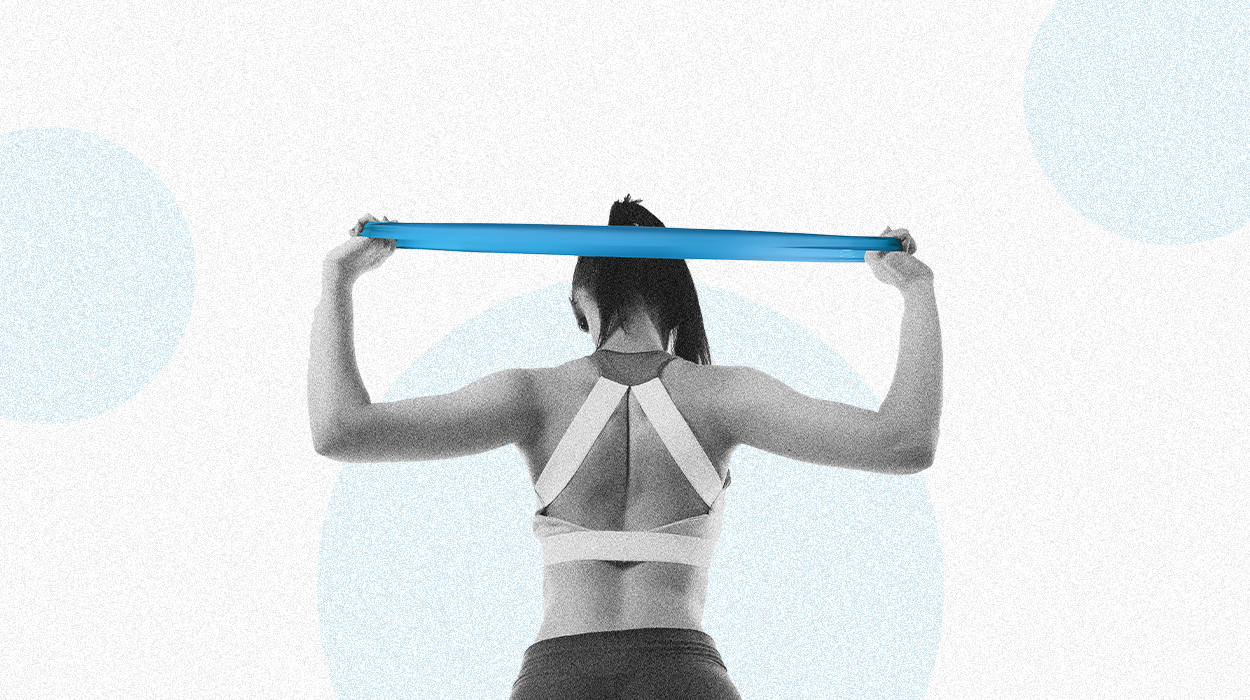
If you want to build muscle strength or need support as you recover from an arm injury, you may want to try a resistance band arm workout. The resistance and tension of the bands can help you work out at any angle, giving various benefits to the muscles[1] of your upper body.
These types of exercises target your upper body and help strengthen your core. This maximizes your fitness and total-body support. As you’re toning up and building muscle, you may want to include a fat burner or alter your diet if weight loss is your goal.
8 Best Arm Workouts With Resistance Bands
Best Resistance Band Arm Workout To Try Now
Let’s check out some of the best resistance band exercises that are sure to give you a killer arm workout:
Overhead Tricep Extensions
This resistance band arm workout acts on your tricep muscle group. This versatile workout can be done when you’re traveling or at home and is a generally safe option for preventing full-body strains.
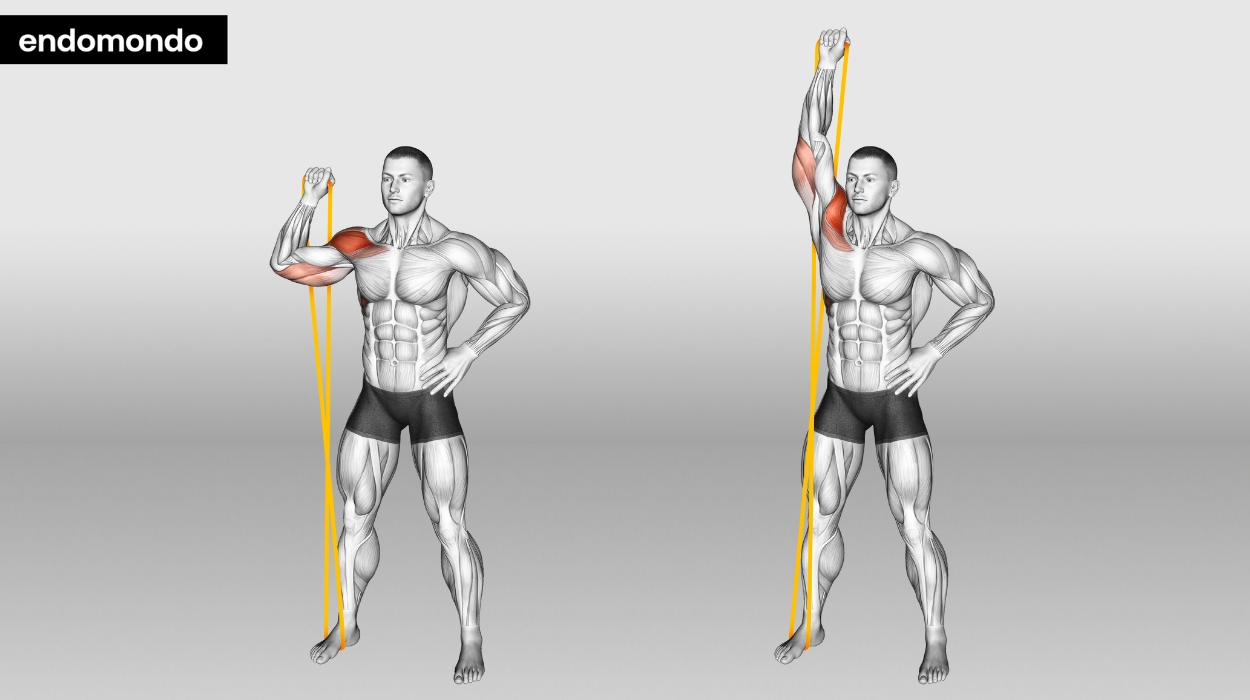
How to do:
- Begin with one left foot forward, with the resistance band resting underneath the back right foot.
- Stretch the band up behind you and grab a handle in each hand. Fully extend your arms so they are straight above your head, and the band is taut.
- Slowly lower the handles behind your head, stopping once your elbows are bent 90 degrees.
- Gradually press back up, raising your hands back above your head.
Tips:
- Maintain a stable stance with feet hip-width apart, engaged core, and slightly bent knees to protect your lower back.
- Start with a manageable weight to ensure proper form and focus on control.
- Avoid locking your elbows completely; keep a slight bend to protect joints and maintain muscle engagement.
Optimal Sets and Reps: 3 sets of 12-15 reps.
Tricep Pushdowns
Instead of using a cable machine, you can revamp this tricep workout to do some resistance band arm exercises. Doing this exercise lets you give attention to your triceps without pressuring your shoulder height or rotator cuff.
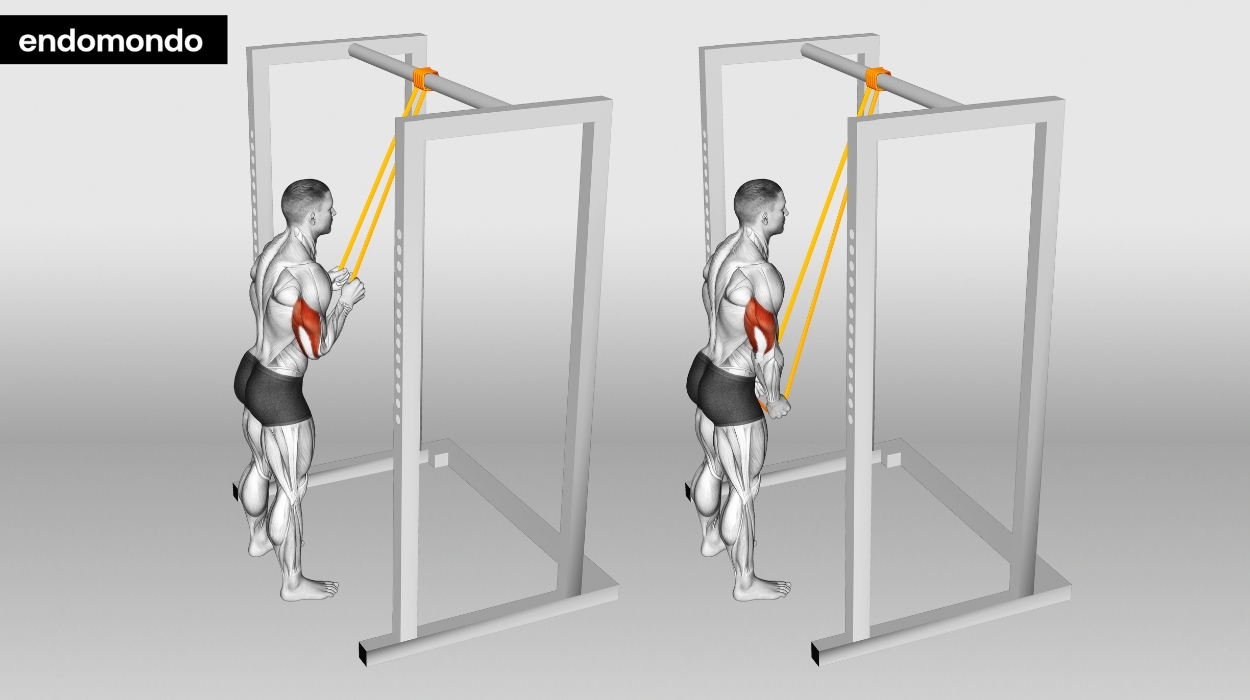
How to do:
- Attach your band to an anchor above you. Stand with your feet shoulder-width apart, holding the resistance band with both hands, palms facing each other.
- Keeping your elbows close to your body, extend your arms slowly and pull the band down until your arms straighten out.
- Pause and sustain this position, release, and return to the starting position.
Tips:
- Maintain a stable stance with feet shoulder-width apart, knees slightly bent, and core engaged for proper stability during the exercise.
- Use a palms-down grip with hands shoulder-width apart, keeping wrists aligned with forearms to prevent strain.
- Focus on controlled movement, keeping upper arm muscles stationary and using triceps to push the bar down; avoid using momentum or swinging.
Optimal Sets and Reps: 3-4 sets of 12-15 reps.
Tricep Kickbacks
This tricep exercise is typically done with dumbbells but can be made into a resistance band exercise.
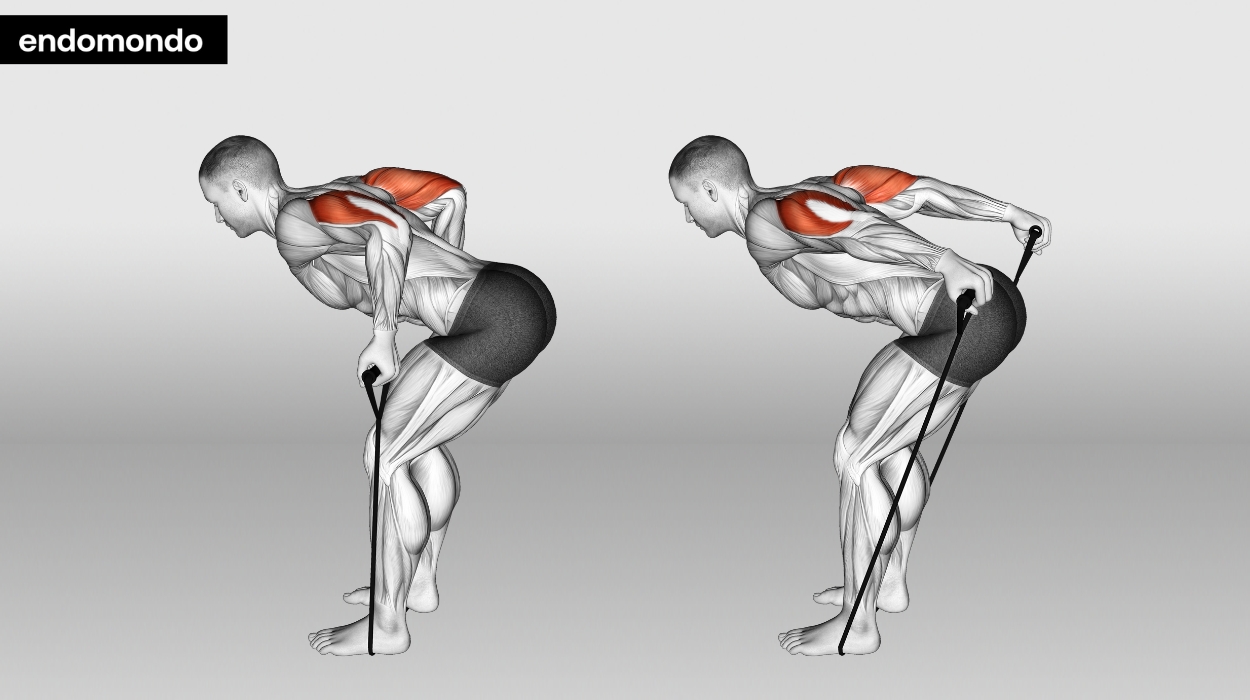
How to do:
- Attach your resistance band to an anchor about the height of your waist. Hold the handles in both hands with your palms facing inward.
- With your knees slightly bent, hinge forward at the waist while maintaining straight arms and spine.
- Proceed by straightening your elbows, keeping your upper arms tucked and close to your body.
- After pausing, bend your elbows to bring the handles back to your starting point.
Tips:
- Keep your back straight and core engaged to maintain a stable posture throughout the exercise.
- Use a weight that challenges your triceps without compromising proper form; avoid swinging your arms.
- Focus on the full range of motion by fully extending your arm behind you and squeezing your triceps at the top of the movement.
Optimal Sets and Reps: 3 sets of 12-15 reps
Overhead Press
The overhead press is an arm resistance band workout that works out your arms and gives great attention to your shoulder muscles.
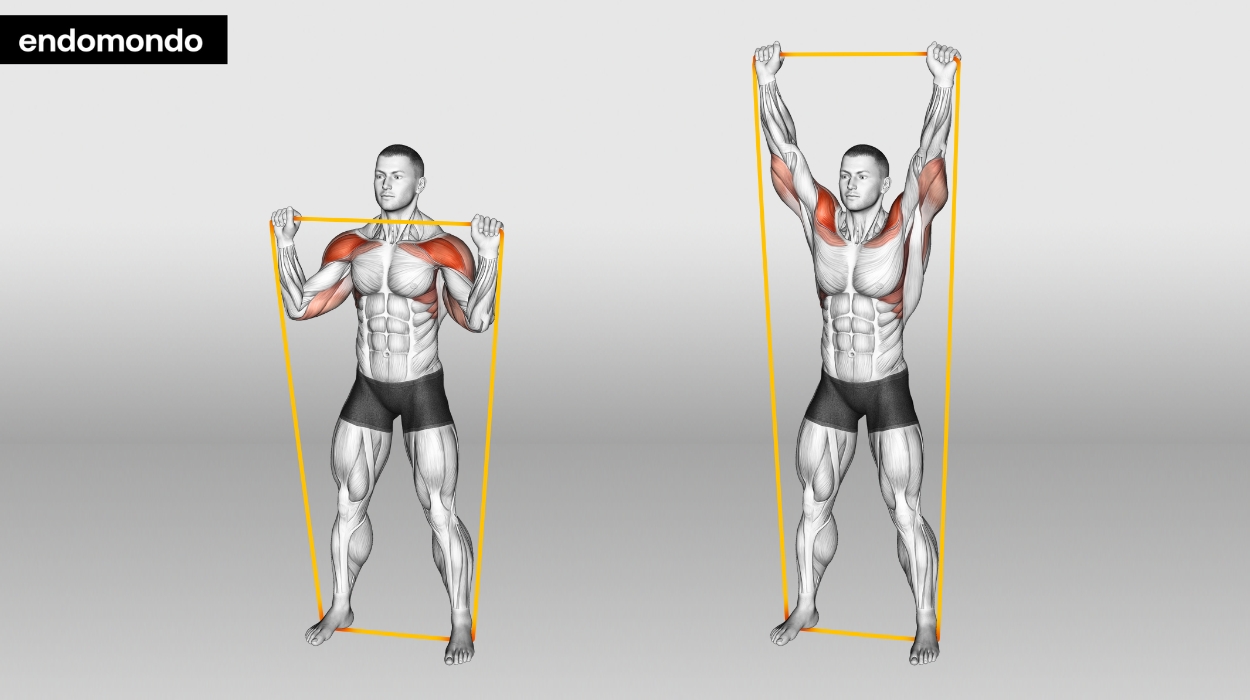
How to do:
- Stand with your feet at a hip-width distance, with your resistance band underneath your feet.
- While gripping your resistance band with both hands, curl your arms to line your hands up with your shoulders. Do this with your elbows pointed to the sides and palms facing forward.
- Press your arms straight, moving the band overhead and going against its resistance. As you do so, squeeze the glutes and keep your core engaged.
- Bring your arms back down so your hands are aligned with your shoulders.
- Return to the starting position.
Tips:
- Keep your wrists in line with your forearms and avoid excessive arching of the lower back to prevent injury.
- Press the weight overhead in a controlled manner, exhaling as you push it up, and avoid using momentum or jerky movements.
- Ensure a full range of motion by lowering the weight until your elbows are at a 90-degree angle or slightly below, then press it fully overhead for the best results.
Optimal Sets and Reps: 2-3 sets of 12-15 reps
Front Raises
The Front Raises exercise is a great resistance band upper body workout that targets the anterior deltoids. Upper body strength is improved, and the stability and mobility of your shoulders are also upgraded. Working on the shoulders can help prevent injuries.

How to do:
- Use both hands to grasp the resistance band after looping it under your feet.
- With your arms at your side and palms facing back, raise them straight in front of you so they’re parallel to the floor.
- Hold your hands at shoulder level, pause, and slowly lower back to the initial position by your thighs.
Tips:
- Focus on a slow and controlled movement throughout the exercise, emphasizing the contraction of your front deltoids.
- Avoid excessive swinging or using your lower back to lift the weights; maintain a stable and upright posture.
- Keep your wrists in a neutral position while lifting the weights to minimize strain on your wrists and maximize shoulder engagement.
Optimal Sets and Reps: 3-4 sets of 8-12 reps.
Lateral Raises
This armband workout is a simple and efficient way to develop your lateral deltoids.
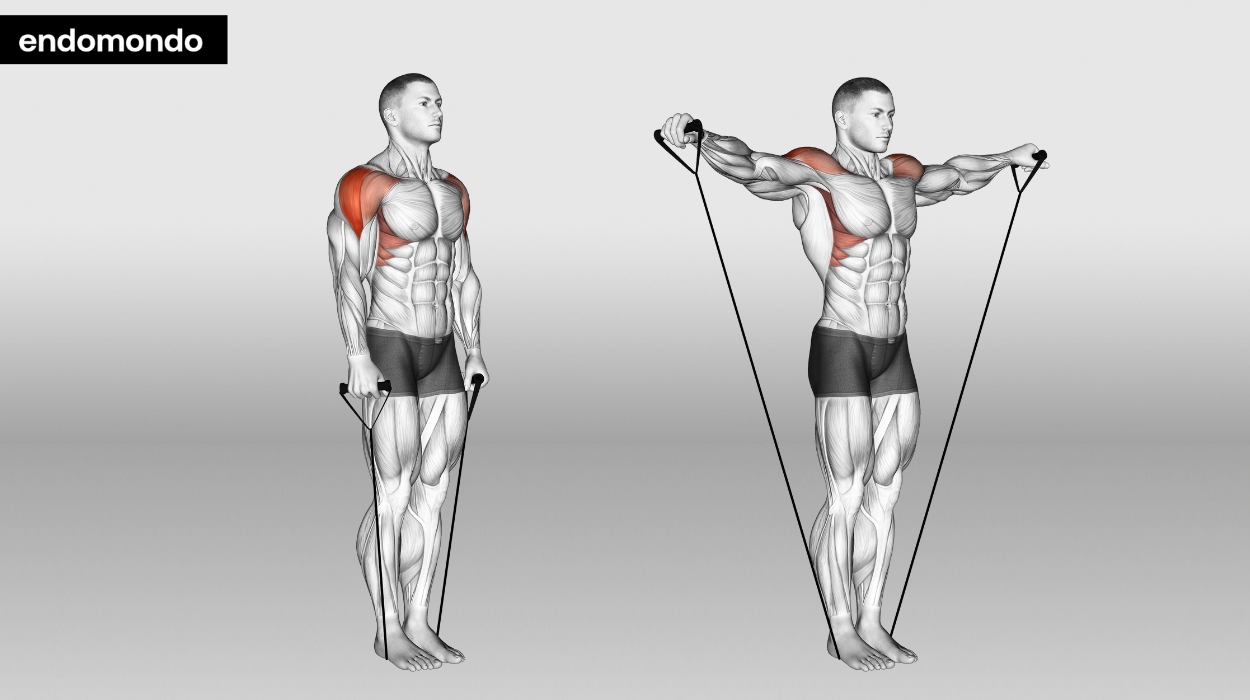
How to do:
- Stand upright with your back straight, chest tall, and feet hip-width apart as you stand atop the band.
- With both hands, grab a band handle, and turn your palms inward.
- Slowly lift your arms upward and out to the side, maintaining slightly bent elbows as you do so.
- Once your arms are parallel to the floor, pause, slowly lower your hands down to your sides, and then repeat.
Tips:
- Maintain a slight bend in your elbows to reduce strain on the joints and focus the effort on your lateral deltoids.
- Lift the weights in a controlled manner, avoiding any swinging or using momentum during the exercise.
- Keep your core engaged and maintain a neutral spine to stabilize your body while performing lateral raises.
Optimal Sets and Reps: 4 sets of 12-15 reps.
Bicep Curls
Exercising your biceps is a great way to enhance your upper arm strength and enable efficient mobility of the forearm.
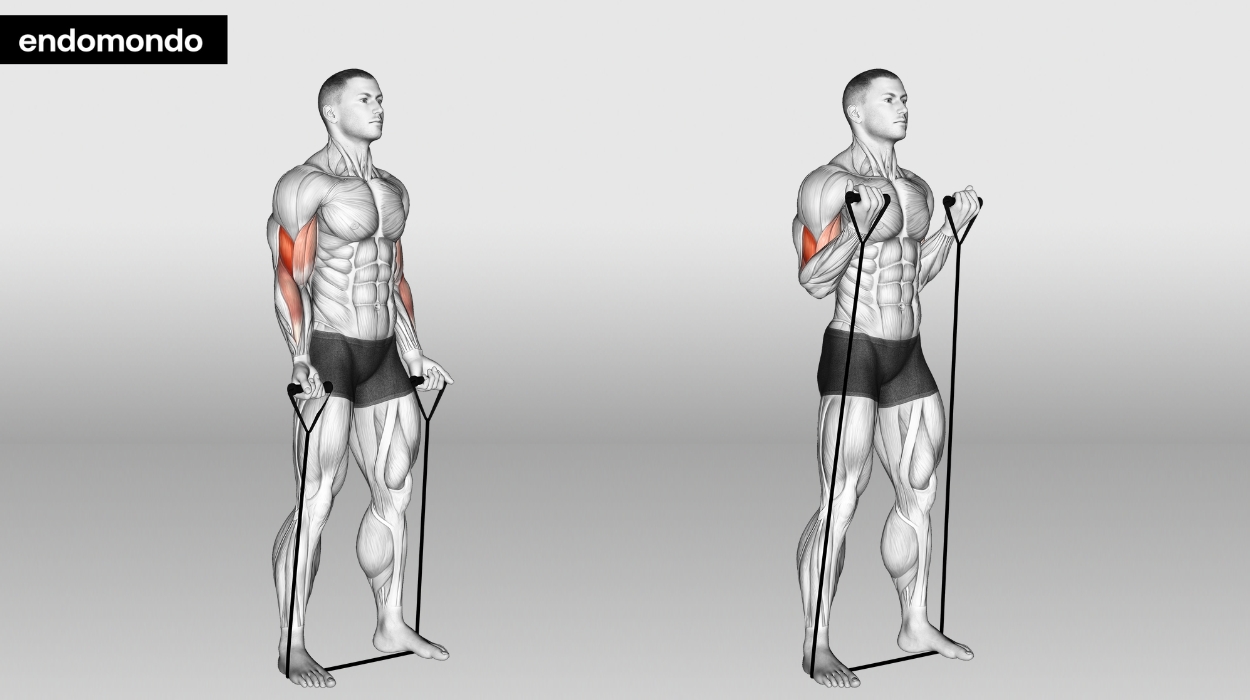
How to do:
- Situate yourself so that your feet are shoulder-width apart while standing on the band.
- Turn your palms to face upward and bend your elbows as you curl the handles towards your shoulders.
- Uncurl your arms slowly, straightening them back to your sides.
Tips:
- Maintain a firm grip on the weights or barbell throughout the exercise to prevent them from slipping or rotating in your hands.
- Focus on the biceps as the primary muscle working; avoid excessive involvement of your shoulders or back by keeping your elbows steady at your sides.
- Control the eccentric (lowering) phase of the curl; don’t let the weights drop quickly, and resist gravity to work your biceps throughout the entire motion.
Optimal Sets and Reps: 3 sets of 10-15 reps.
Hammer Curls
This resistance band bicep workout can be great for building up your biceps and your forearms.
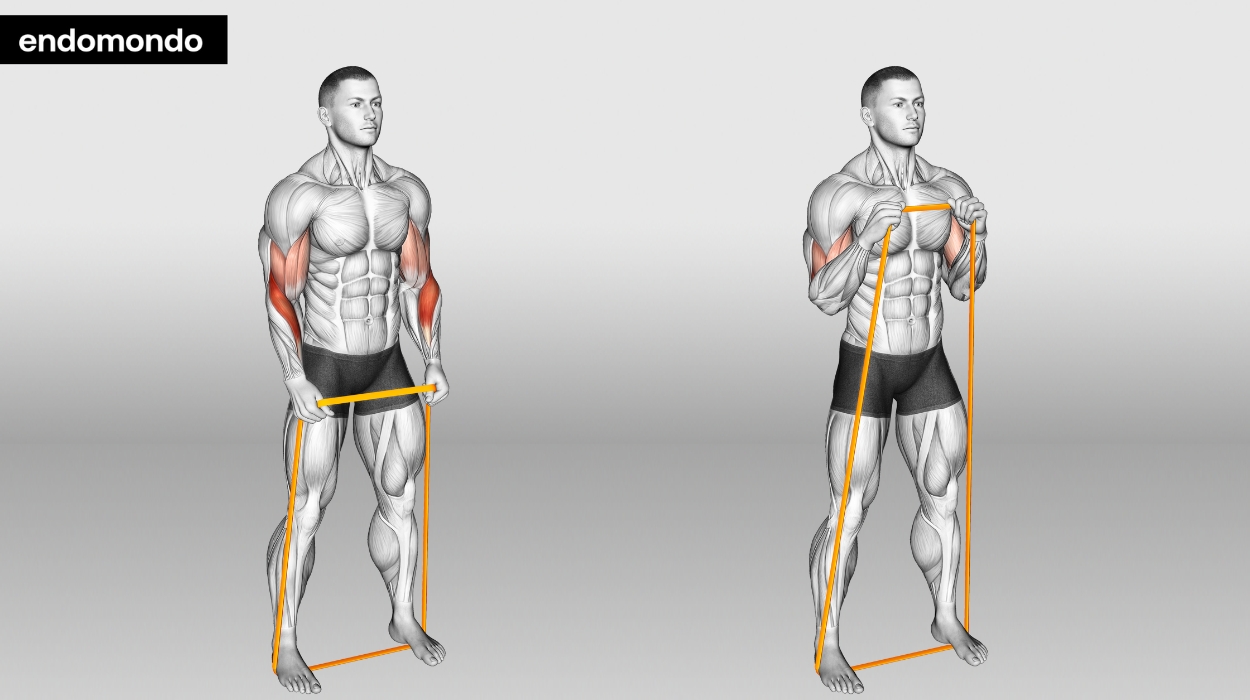
How to do:
- Spread your feet shoulder-width apart to begin, standing on top of the band while doing so. Grasp a handle in each hand and have your palms facing each other.
- Without moving your upper arms, bend your elbows to curl the resistance band arm towards your shoulders.
- After pausing for a moment, lower back into the starting position.
Tips:
- Maintain a firm grip on the weights, keeping them parallel to each other throughout the exercise to target the brachialis effectively.
- Focus on the brachialis muscle in the center of your upper arm; avoid excessive swinging or using momentum to lift the weights.
- Keep your elbows close to your sides throughout the movement to isolate the biceps and brachialis and minimize shoulder involvement.
Optimal Sets and Reps: 3 sets of 12-15 reps.
Benefits Of Resistance Band Arm Exercises

Increase In Muscle Mass
Resistance band arm workout will have you toning up and building muscle in no time. Your strength and muscle mass will likely increase. Bicep and tricep workouts will result in stability, toned arm muscles, and a strengthened body.
Working on your shoulder and body strength will improve your posture and the ability to support functions like arm movement and carrying loads. Shoulder strength is required for daily activities, and the stability it provides can reduce the risk of shoulder injuries that are detrimental to lifting objects, pushing or pulling doors, or sitting upright at work.
Bicep workouts give you an extra boost regarding stamina and speed when running or swimming. Strong triceps guide your ability to flex and bend and are vital for getting dressed or grabbing something stored in a high place.
Weight Loss
Resistance band workouts are great for building muscle and burning fat. Your elevated heart rate can also positively affect circulation and promote adequate blood flow. A healthier heart can safeguard against weight gain and prevent arterial damage due to elevated blood sugar, hypertension, and high cholesterol.
With your muscle fibers working overtime and additional resistance being provided in your movements, a resistance band arm workout can support your weight loss goals.[2] Keeping excess weight off your body can lighten the load on your joints and muscles,[3] preventing arthritis or osteoporosis-related issues.
Skeletal Protection And Rehabilitation
Not only can arm workouts with resistance bands be a strength and muscle builder, but they can also be vital for rehabilitating those muscles in the event of injury. The resistance band arm workout allows you to focus on the range of motion[4] for joints or areas impacted by arthritis. Just stretching your arms or rolling your shoulders in several directions can loosen up stiff and painful muscles.
For example, bicep and shoulder injuries[5] are very common complications, and resistance training[6] can be used to revitalize the muscle fibers and improve the full range of motion. Resistance exercises work on the trapezius muscle, which supports upper body function. Rehab regimens target the trapezius and scapula,[7] better known as the shoulder blades, and help alleviate neck pain and tension in the shoulders and back muscles.
Aside from rehabilitative purposes, resistance regimens are protective as tricep workouts can promote good posture, maintain your balance, and limit the chances of falls. You may also see reduced pain as you carry out daily tasks. Putting your tote bag over your shoulder or carrying in your load of groceries won’t be so stressful for your muscles.
Safety And Precautions For Arm Exercises With Resistance Bands
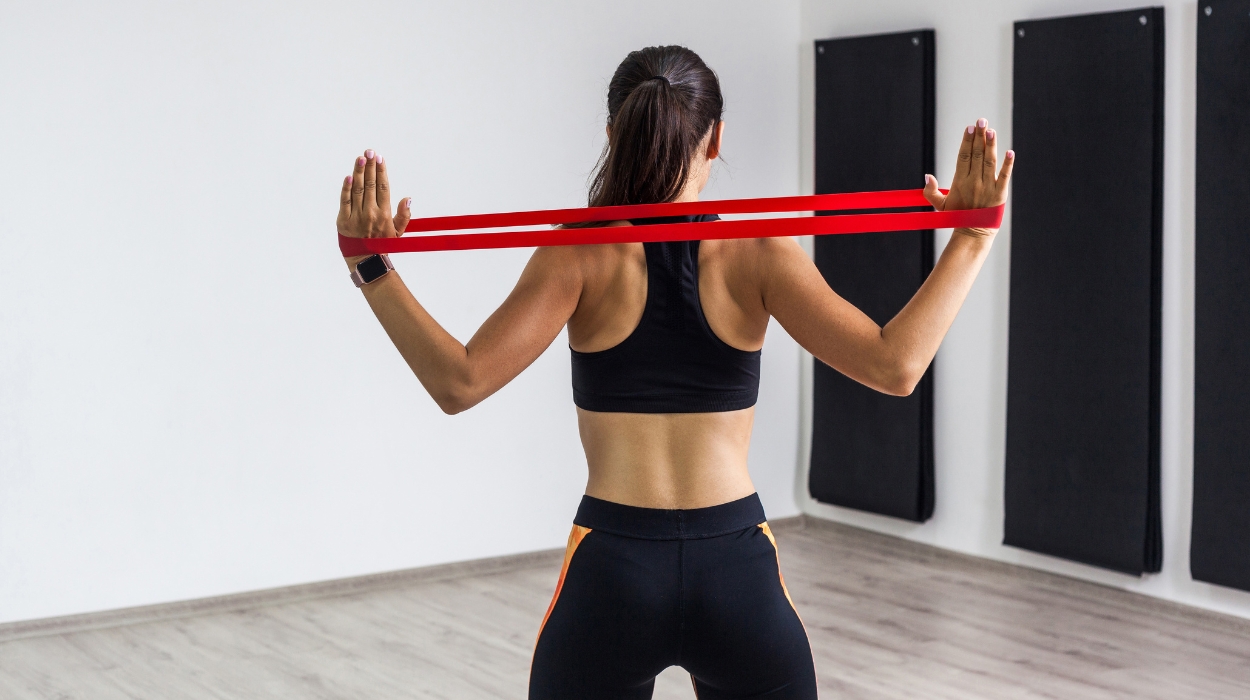
As you go forward with these exercises, ensure you know how to use resistance bands for your arms. Select your bands according to the exercises you’ll be doing and what is required of them, as there is a range of tension or resistance levels. When attaching your bands to surfaces, make sure to keep the band secured.
Maintaining proper technique and form and avoiding increasing intensity beyond your capabilities or overstretching your equipment is very important. Keep your core muscles engaged and a slight bend in your elbows.
Consider working with a certified personal trainer to address your individualized needs and ensure you’re exercising with the proper form. Examine the condition of your bands for wear and tear. Dress appropriately, particularly with your footwear, so you don’t slide.
The Bottom Line
Arm workouts and core exercises benefit the body, giving abdominal muscles better ability to serve as a foundation for your shoulders, support the weight your back carries, and ultimately enhance total-body fitness. Throughout your fitness journey, safely engage in resistance band workouts to give proper balance and stamina.
Upper-body workouts tone you up and build muscle, but spot reduction isn’t likely, so you may want to invest in fat-burning supplements to help with weight loss. Vamp up your intake of nutrients to encourage bodybuilding. In addition to strength training, consume adequate protein to increase your muscle mass and promote weight loss.
Frequently Asked Questions
Resistance bands are great for toning and strengthening the arm muscles and upgrading mobility and flexibility. This form of strength training can help improve muscle gains and athletic performance.
Resistance bands can be used to build muscle just like free weights and other weighted equipment. Plus, they’re easy to transport and can fit in your gym bag.
The resistance curve may make the band the superior choice. Greater tension is beneficial for building strength, and it takes the muscles close to failure, which is beneficial for hypertrophy. If you have questions about what equipment is right for your training session, consider working with a certified personal trainer.
Resistance bands and dumbbells are both great for muscle building, but the resistance bands allow you to work out with more versatile angles. The ability to push and pull them makes them suitable for rehab.
Resources
- Santos, J., Aryane Flauzino Machado, Jéssica Kirsch Micheletti, Castilho, A., Allysiê Priscila Cavina and Carlos Marcelo Pastre (2019). Effects of training with elastic resistance versus conventional resistance on muscular strength: A systematic review and meta-analysis. Sage Open Medicine, [online] 7, p.205031211983111-205031211983111. doi:https://doi.org/10.1177/2050312119831116.
- Liu, X., Gao, Y., Lu, J., Ma, Q., Shi, Y., Liu, J., Xin, S. and Su, H. (2022). Effects of Different Resistance Exercise Forms on Body Composition and Muscle Strength in Overweight and/or Obese Individuals: A Systematic Review and Meta-Analysis. Frontiers in Physiology, [online] 12. doi:https://doi.org/10.3389/fphys.2021.791999.
- Proietto, J. (2020). Obesity and Bone. F1000Research, [online] 9, pp.1111–1111. doi:https://doi.org/10.12688/f1000research.20875.1.
- Andersen, V., Olaf Prieske, Stien, N., Cumming, K., Erik, T., Paulsen, G., Roland, Pedersen, H. and Saeterbakken, A.H. (2022). Comparing the effects of variable and traditional resistance training on maximal strength and muscle power in healthy adults: A systematic review and meta-analysis. Journal of Science and Medicine in Sport, [online] 25(12), pp.1023–1032. doi:https://doi.org/10.1016/j.jsams.2022.08.009.
- Gaballah, A., Zeyada, M., Adham Elgeidi and Eadric Bressel (2017). Six-week physical rehabilitation protocol for anterior shoulder dislocation in athletes. Journal of exercise rehabilitation, [online] 13(3), pp.353–358. doi:https://doi.org/10.12965/jer.1734976.488.
- Nuradebah Burhan, Mohammad ‘Afif Kasno, Ghazali, R., Said, R., Shahrum Shah Abdullah and Mohd Hafiz Jali (2017). Analysis of the Biceps Brachii Muscle by Varying the Arm Movement Level and Load Resistance Band. Journal of Healthcare Engineering, [online] 2017, pp.1–8. doi:https://doi.org/10.1155/2017/1631384.
- Kang, T. and Kim, B. (2022). Cervical and scapula-focused resistance exercise program versus trapezius massage in patients with chronic neck pain: A randomized controlled trial. Medicine, [online] 101(39), pp.e30887–e30887. doi:https://doi.org/10.1097/md.0000000000030887.




